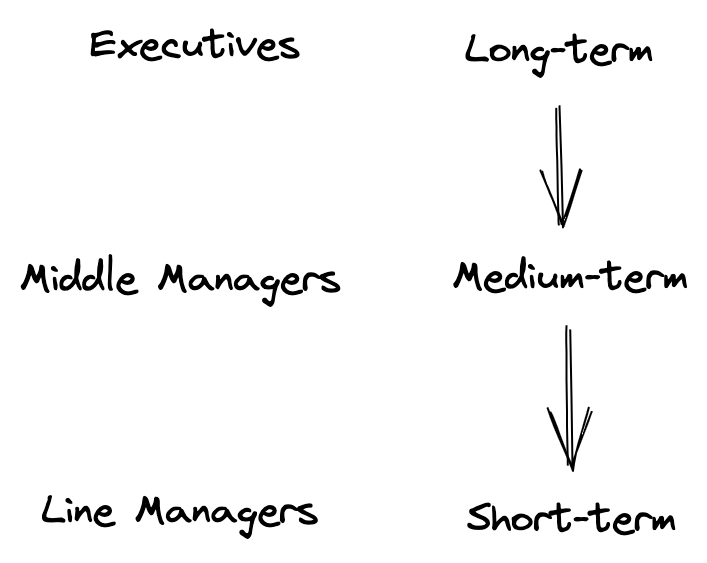
Successful teams follow three disciplines pretty well: planning, execution, and control. Teams can be of any size: a small team, a department (collection of teams), or a company (collection of departments). When I mention successful teams, I’m referring to the teams that consistently reach their goals. This excludes sparse successes where they get there by chance. This generic trio fits into any operations style, from waterfall to agile.
The topic covers a lot of ground on team success. I break this topic into four parts to keep the essay reader-friendly. In this essay, I expand on planning.
Planning
Planning refers to understanding where metrics are and where they should be. Metrics are different from team to team, depending on their charter. For example, a metric for a for-profit company is the amount of profit, while a metric for an infrastructure team is to keep the platform’s availability within SLA.
Teams plan for different durations:
- Long-term (12+ months): Long-term planning is usually a vision for a team. The focus is on key metrics. For example, a B2C team will reach 5M daily active users in three years.
- Medium-term (3-9 months): Medium-term planning is the interim steps that the team needs to take to meet the long-term plan. For example, reaching 1M daily active users in the next six months is a step towards getting 5M daily active users in three years.
- Short-term (1-4 weeks): Short-term planning is tactical, focused on tangible items such as creating a web page or running an A/B test. They are essential to reach medium and, consequently, long-term plans.
For long-term planning, executives are more involved, while line managers are the primary stakeholders for short-term planning.

Planning Tips
Some tips on how to have better planning and avoid pitfalls:
- There is no magical planning framework. No planning framework guarantees the success of a team. Each planning framework shared publicly by a company represents what works best. Each framework comes with hidden attributes from the creator’s company, such as the size of the company, appetite for risk, financial stability, product-market fit, and team organization.
- Knowing where you are today is as important as where you want to be. You need to know the start and end points for any successful plan. For example, if a team wants to improve their velocity, they need to know how much their velocity is today. Without knowing where the metrics are today, any plan is simultaneously a good and bad plan.
- Beware of rushed planning. Planning takes time. While shortening the time seems like saving time, it can cause the team to rush into planning without enough preparation. Without enough preparation, rushed planning can cause teams to prioritize the wrong items in the plan and causes churn in future. Recency bias finds its way into the plan in this case.
- Be SMART. SMART stands for specific, measurable, achievable, relevant, and time-bound. Planning is more effective when it follows these rules. This topic deserves its own article. You can read more on this page.
- Account for toil and other unplanned works. Unless a team works on completely new stuff, they have toils and unplanned work. These include supporting stakeholders, addressing bugs, dealing with incidents, etc. Good planning considers these and leaves room for the team member to deal with them.
- Get alignment from all stakeholders. A team works on products and services that are used by others. When a company grows, the number of additional steps a team should take to provide these products and services will also grow. Other teams, such as legal, security, and finance, must be involved to ensure a smooth rollout of the feature. Nothing is more demoralizing than working on a project for so long and being unable to ship it for external reasons. The RACI matrix is an excellent tool to capture stakeholders early on and understand their roles.
- Make sure to capture users’ feedback. A team works on products and services that internal or external users use. To ensure the team’s time is spent well, the team needs to listen to what the users want and plan based on that. Similar to the previous point, creating a new feature or tool without a desired adoption is demoralizing.
- Implementation is the easiest part to plan for. Implementation is where people are comfortable planning. It is within their control. However, some elements, depending on the project type, can affect the execution. Some examples are stakeholder communication, change management, documentation, bugs, churns, scope changes, etc. Good planning minimizes the risk by allocating enough time to address known unknowns—plan for the unexpected.
- Planning is not democracy. Each team should have one and only one accountable person. That is the head of that team. For an engineering team, it is the EM. For a data department, it is the VP of Data. And, for the whole company is the CEO. The head of the team has the final call on the planning since they are accountable for it. Good leaders seek others’ opinions and input. They make sure they hear all stakeholders. But the final call is on them.
- Planning is top-down. Planning works best when implemented well across the organization. If priorities constantly shift at higher levels, no matter how well sub-team planning is, they get affected and have to follow the chaotic behaviour of the organization.
Planning Deficiency Symptoms
If you are a leader or individual contributor, there are some signals that planning is not working properly within your team. Some symptoms that show planning needs improvement, assuming the team has a strong execution muscle:
- A team consistently fails to reach the planned state. Most of the time, when someone looks at the plan, it seems excellent and aspirational. However, the team fails to commit to these promises. When this is happening, a great leader spends time finding the root cause and addressing it properly.
- Long-term plans have tactical items instead of being metrics-driven. When you see “Implement X …,” “Use Y …,” or any of their variations in a long-term plan, it is a sign that the team will struggle in the future when “X” or “Y” is not delivering what it promises to move the key metrics.
- Inputs from stakeholders are missing. These stakeholders range from finance to legal to security. For example, when a team commits to a plan without knowing if there is a budget for contracting a vendor, they will get into negotiation with finance to secure funds. Worst case scenario, the team has spent much time on the project, and there is no budget to continue. A good leader makes sure stakeholders are aligned before committing to a plan.
- There is a lack of data backing a proposed plan. When asking “why?” on planned items doesn’t lead to a business value through data-driven analysis, it is a sign that the plan is more a bet than a carefully researched plan. The bet may or may not help with the business metrics at the end.
- A plan keeps changing- a lot. When a team starts a cycle with a plan and ends it with a different state, there is a sign that something is not working. This is usually due to higher-priority changes or unplanned work. While change is inevitable, having a lot of it consistently disrupts teams’ productivity.
- The planning framework keeps changing. While rare, it may happen when a team fails consistently to meet a plan or a new manager joins a team. Every planning frameworks have its merits. But, it is rarely the reason that teams fail. Without addressing underlining issues, the failure starts happening again with the new framework.
- A team doesn’t allocate enough time for planning. Planning is as much work as anything else. It requires its own dedicated time. Changes to longer-term plans are more costly than shorter-term ones. Without allocating enough time, items on a plan can be of low quality – resulting in churns.
- Planning is done in a silo. When the impact of a project is beyond its local team, other stakeholders must be involved in the planning phase. This is to prevent plans that oppose each other or ensure the other parts of the organization are aligned with the outcome.
- Consistently hearing chatter about planning is a waste of time. When there is smoke, there is fire. When a new leader joins a new team, listening to water cooler chats is crucial. When planning is not working, people talk about it, usually sarcastically. This is a good sign that the leader should evaluate the reason for planning shortcomings before jumping to a conclusion about the team’s performance.
Takeaways
Successful teams consistently reach their goals by adhering to three key disciplines: planning, execution, and control. This essay focuses on the importance of planning, which entails understanding a team’s current metrics and desired future state. It is crucial to avoid common pitfalls, such as rushed planning or not accounting for toil and other unplanned work, by being SMART (specific, measurable, achievable, relevant, and time-bound).
A successful planning process should involve input from all stakeholders, ensuring alignment and addressing any potential obstacles that may arise. This includes capturing user feedback, accounting for stakeholder communication, and dealing with challenges like scope changes and documentation. The planning process should not be a democracy, with the team leader taking ultimate responsibility for the plan and its outcomes. Effective planning should be implemented top-down, with priorities set at higher organizational levels.
Several symptoms indicate planning deficiency, such as a team consistently failing to reach their planned state, long-term plans containing tactical items, or a lack of data-driven analysis. Other signs include frequent changes to the plan, a constantly shifting planning framework, or planning being done in silos. To ensure the success of a team, leaders must address these issues and allocate adequate time and resources to the planning process while also being attentive to feedback and team morale.
